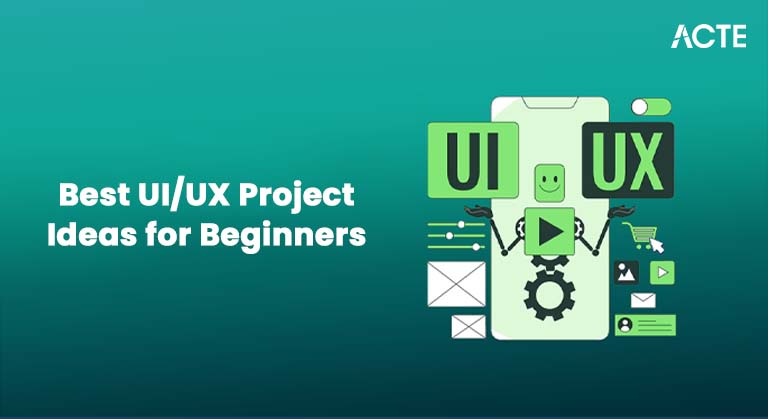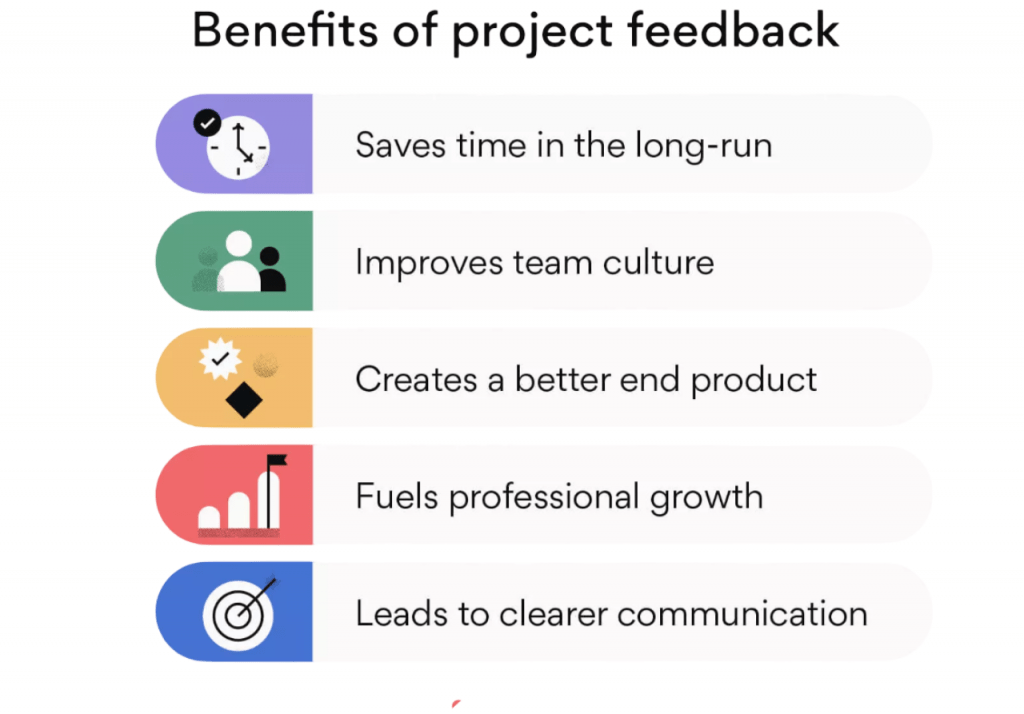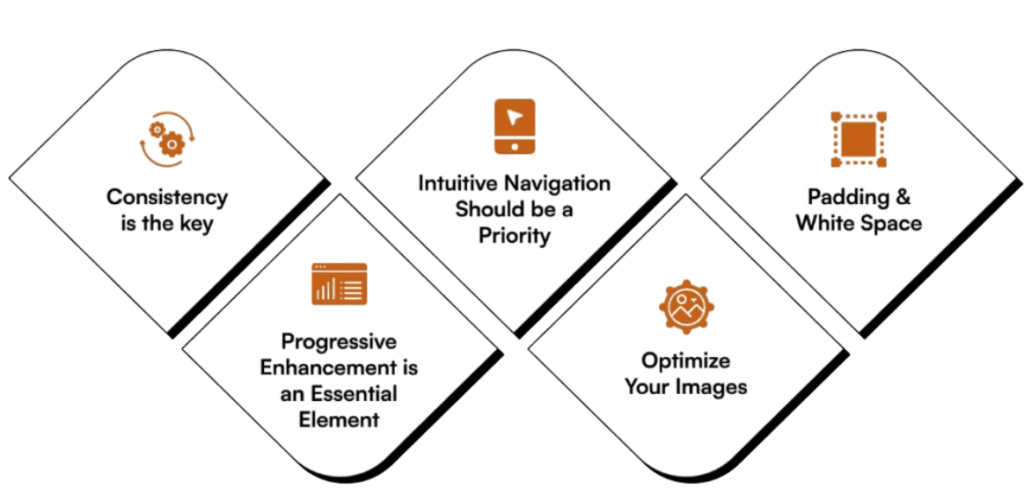
- Importance of UI/UX Projects
- Beginner UI/UX Projects Ideas
- Intermediate-Level Projects
- Advanced UI/UX Projects
- Case Study Formatting
- Real-time User Feedback Projects
- Responsive Web Projects
- Mobile App Redesigns
- UX Research-Based Projects
- E-commerce and SaaS Projects
- Tools and Resources
- Showcasing Projects on Portfolio
- Final Thoughts
Importance of UI/UX Projects
In UI/UX design, theoretical knowledge alone is insufficient to build competence. Practical UI/UX Projects are critical because they. They bridge the gap between design and communication, making complex systems simple and approachable a core objective of UI/UX Training, which equips learners to translate abstract workflows into intuitive, user-friendly interfaces. They help designers go from learning in theory to practicing their skills. By taking on real-world assignments, designers can turn their academic knowledge into effective solutions. They also create a strong portfolio that shows what they can do to potential employers and clients. These projects provide excellent chances to improve problem-solving skills. They also help develop good communication strategies through working with different stakeholders and build strong user empathy by facing real user challenges. Beyond just technical skills, hands-on projects boost confidence and prepare designers for tough interviews and work settings. Ultimately, these practical experiences close the gap between classroom learning and real-world practice. They help designers become capable professionals who can handle complex design situations and create valuable, user-centered solutions.
Ready to Get Certified in UI/UX Design? Explore the Program Now UI/UX Design Online Training Offered By ACTE Right Now!
Beginner UI/UX Projects Ideas
For aspiring UI designers wanting to improve their skills, taking on smaller projects offers a great way to grow professionally over time. Starting with a personal portfolio website helps designers display their resumes and project samples while learning important layout, typography, and responsive design principles. Moving on to more complex tasks, like designing a persuasive product landing page with effective calls to action and creating easy-to-use login and signup screens, builds essential interaction design skills. Practical projects like developing a weather app UI and designing attractive blog layouts let designers explore iconography, data visualization, text hierarchy, and visual communication techniques. These thoughtfully chosen projects teach key UI basics and provide hands-on experience in creating responsive, user-centered designs that show technical skills and problem-solving abilities.
Intermediate-Level Projects
Once comfortable with basics, move to projects requiring user flows, data handling, and multi-screen navigation:
Analytics Dashboard
- Design charts, stats, and filters.
- Focus on clear data visualization and information hierarchy.
Recipe or Food Delivery App
- Multi-screen design including browsing, filtering, ordering.
- Emphasize user flow and interaction design.
Task Management Tool
- Design task creation, categorization, and reminders.
- Implement simple notifications and status updates.
Event Booking Platform
- Design event lists, ticket purchase flows.
- Work on multi-step checkout and confirmation screens.
Travel Booking Interface
- Design search, selection, booking, and itinerary screens.
- Manage complex user flows.
Intermediate projects sharpen your ability to design end-to-end user experiences and handle more data-driven and interactive elements.
To Explore UI/UX in Depth, Check Out Our Comprehensive UI/UX Online Training To Gain Insights From Our Experts!
Advanced UI/UX Projects
Advanced projects involve complex workflows, multiple personas, and require deep UX thinking and technical knowledge:
E-commerce Platform
- Design full shopping experience: browsing, product detail, cart, checkout, user accounts.
- Handle filtering, personalization, and payment UX.
SaaS Dashboard
- Build complex admin interfaces with data visualization and multi-user roles.
- Emphasize task efficiency and error handling.
Mobile Banking App
- Design for high security and trust.
- Create flows for transfers, bill payments, notifications.
Health/Fitness Tracker
- Multi-metric dashboards, goal setting, progress visualization.
- Focus on motivation and personalization.
Social Networking App
- Design feeds, chat, profiles, notifications.
- Prioritize privacy, engagement, and ease of use.
Advanced projects demonstrate your ability to handle real-world complexity and business constraints.
Case Study Formatting
Crafting a strong case study is vital for showcasing your design process and professional journey effectively.A well-structured case study starts with a brief overview that introduces the project’s purpose and scope, followed by a clear problem statement that defines the challenge you addressed an essential skill emphasized in UI/UX Training, where designers learn to articulate design intent and problem-solving logic through compelling narratives. By including user research, competitor analysis, and developed personas, you offer a complete view of your strategic approach. Visualizing user interactions with journey maps and wireframes shows how you turned research insights into real design solutions. Detailing your design choices, from color to typography and layout, provides insight into your thinking. It’s also important to highlight the challenges you faced and the innovative solutions you created, which shows your problem-solving skills. User testing feedback and later revisions demonstrate your dedication to improving the design, while presenting the final polished screens showcases the end result. When possible, include measurable results or impact metrics to back up the project’s success. Ending with a reflective section on lessons learned and potential future improvements adds depth and shows ongoing professional growth. Adding visuals like images, diagrams, and flowcharts throughout the case study improves clarity and engagement, turning a technical document into a compelling story of design excellence.
Looking to UI/UX Training? Discover the UI/UX Design Expert Masters Program Training Course Available at ACTE Now!
Real-time User Feedback Projects
Improving design quality requires a thoughtful approach to user feedback that goes beyond traditional methods. By using live user insights from platforms like Figma and InVision, designers can test their prototypes in real-time and get honest perspectives.

Gathering feedback involves various channels, including usability testing platforms such as UserTesting and Maze, targeted surveys via Google Forms, and direct observations of user interactions. Conducting A/B testing on design variations provides a deeper understanding of user preferences. This allows designers to continuously improve their solutions. This user-focused approach not only boosts design skills but also leads to more intuitive, responsive, and effective product experiences that meet user needs and solve their problems.
Responsive Web Projects
Designing for multiple devices is mandatory in modern UI/UX:
Project Ideas:
- Convert a fixed desktop site to a fully responsive site.
- Design mobile-first layouts for blogs, portfolios, or shops.
- Create adaptive navigation menus.
- Design responsive forms and data tables.
- Test your projects on different screen sizes and devices.

Mastering media queries, flexible grids, and fluid images ensures accessibility across devices.
Preparing for UI/UX Design Job Interviews? Have a Look at Our Blog on UI/UX Design Interview Questions and Answers To Ace Your Interview!
Mobile App Redesigns
Redesigning an existing app helps you practice analysis, critique, and improvement:
Steps to Redesign:
- Select an app with UX issues or outdated UI.
- Conduct heuristic evaluation.
- Gather user reviews and feedback.
- Identify pain points and prioritize fixes.
- Create improved wireframes and prototypes.
- Implement improved visual and interaction design.
This process develops critical thinking and user advocacy.
UX Research-Based Projects
In UX design, research is essential for creating meaningful, user-centered solutions. By doing user interviews and surveys, designers can gather valuable insights into what users need and prefer. A thoughtful approach includes looking at competitor products to find market gaps and chances for new ideas. Creating detailed personas and empathy maps allows designers to really understand their target audience, while carefully mapping user journeys helps identify key pain points. These research-based methods enable designers to steer their design processes with care and understanding, ultimately leading to solutions that effectively tackle real user problems. By basing design choices on solid research, UX professionals show their ability to create intuitive, user-focused experiences that meet and even surpass user expectations.
E-commerce and SaaS Projects
In the fast-changing digital world, successful UX design needs specific strategies for different business areas. For e-commerce platforms, this means creating user experiences that make it easy to find products. This can be done through filters, personalized suggestions, and sorting options. Building trust is also essential. This can be achieved with clear product pages that display genuine customer reviews and ratings, along with checkout processes that reduce confusion. Features like personalized wishlists, order histories, and targeted offers also improve user engagement and retention. SaaS interfaces require thoughtful design approaches, focusing on dashboards that fit different roles, clear permissions, streamlined workflows, and easy onboarding. By using support systems, preventing errors ahead of time, and providing clear data visuals, designers can change complex interfaces into friendly, actionable experiences. These design methods show a deep understanding of business needs and the skill to create solutions that connect user requirements with technology.
Tools and Resources
The right tools accelerate design and collaboration:
- Design & Prototyping: Figma, Adobe XD, Sketch, InVision.
- User Research: SurveyMonkey, Google Forms, UserTesting, Maze.
- Wireframing: Balsamiq, Moqups.
- Collaboration & Handoff: Zeplin, Jira, Trello, Slack.
- Coding & Testing: VS Code, GitHub, Browser DevTools, Lighthouse.
- Learning: UX Collective, Nielsen Norman Group, Coursera, Interaction Design Foundation.
Stay updated with industry tools for maximum efficiency.
Showcasing Projects on Your Portfolio
Your portfolio is your personal brand and sales pitch:
Tips:
- Use a clean, easy-to-navigate personal website or platforms like Behance, Dribbble.
- Present projects as stories focusing on process and results.
- Include interactive prototypes or live demos.
- Showcase a range of projects demonstrating versatility.
- Highlight your role, tools used, and key learnings.
- Update regularly and remove outdated work.
- Link to code repositories for developer-designer hybrid roles.
- Add testimonials from clients or collaborators.
Your portfolio should reflect your design philosophy, skills, and personality.
Final Thoughts
Practical projects are the backbone of your growth as a UI/UX professional. From beginner exercises like landing pages and login screens to complex SaaS dashboards and e-commerce platforms, every project enriches your skill set and portfolio especially when guided by structured UI/UX Training that emphasizes user feedback loops, responsive design principles, and deep UX research to elevate your work from functional to exceptional. Well-documented case studies and polished portfolios make you attractive to recruiters and clients alike. Keep learning, iterating, and showcasing your best work and your UI/UX career will thrive on it!




